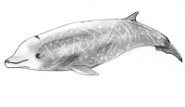 The Cuvier's beaked whale (Ziphius Cavirostris) which is also known as the goosebeak whale is rarely seen in the ocean. Almost all that is known about it comes from stranded or beached animals. There are approximately twenty species of beaked whales, and because they make long and deep dives little is known about most of them. Three or four species including Cuvier's and Baird's Beaked Whales are known reasonably well. The Cuvier's has the tendency to most often strand itself. It is thought that they may be extra sensitive to sound because often the mass beachings are found in noisy seas. During the Middle Ages these shy creatures were thought to be monsters with an owl's head and a fish's body.
The Cuvier's beaked whale (Ziphius Cavirostris) which is also known as the goosebeak whale is rarely seen in the ocean. Almost all that is known about it comes from stranded or beached animals. There are approximately twenty species of beaked whales, and because they make long and deep dives little is known about most of them. Three or four species including Cuvier's and Baird's Beaked Whales are known reasonably well. The Cuvier's has the tendency to most often strand itself. It is thought that they may be extra sensitive to sound because often the mass beachings are found in noisy seas. During the Middle Ages these shy creatures were thought to be monsters with an owl's head and a fish's body.The name goosebeak came from the shape of its head, because its forehead slopes to a short beak with a slight smile which gives it a goose-like profile. Males have two large teeth approximately 5 cm (2 inches) long that are used to fight other males over females. Females have two small teeth that are pointed and remain embedded in the gums. The lower jaw extends beyond the upper jaw as in all beaked whales, but the Cuvier's has two throat grooves that are V-shaped.
Seven meters (23 feet) is the maximum length for Cuvier's beaked whales but the average adult is 5.5 meters (18 feet) and weighs 2500 kilograms (2.
They come in several colors including dark gray, fawn and rusty-brown with the underside being black or dark brown. The color lightens as the whale ages, and the heads of very old whales are completely white. Males have scratches on the side made from other whales. The dorsal fins may be curved, low and broad or triangular and high and the flukes are rounded at the tips. The flippers are small and round at the tip and fit into a depression on the side of the body.
Cuvier's beaked whales mainly like to eat squid, but they will eat deep sea fish and if necessary, crustaceans. They roam all the oceans of the world except the poles but they are so rarely seen that their number is not known. They are rated DD or data deficient on the IUCN Red List of Threatened Species. They stay in deep water of 1000 meters (3,300 feet) avoiding the shallow costal areas. It has been hunted, but so few were caught that it was not considered a threat to the population. It is known that Tiger sharks and Cookiecutter sharks prey on them because of the teeth marks seen on beached specimens. Their acoustic sensitivity seems to be the biggest threat, because strandings are found in water that has human-activated sonar such as the Azores Islands, Caribbean and Gulf of California.
Image of the Cuvier's beaked whale by Bardrock, licensed under GFDL
The Cuvier's beaked whale, goose-beaked whale, goosebeak whale is listed as Data Deficient (DD), inadequate information to make a direct, or indirect, assessment of its risk of extinction, on the IUCN Red List of Threatened Species
Namings for the Cuvier
A young / baby of a Cuvier is called a 'calf'. The females are called 'cow' and males 'bull'. A Cuvier group is called a 'gam, pod or herd'.Countries
Argentina, Australia, Barbados, Brazil, Canada, Chile, China, Comoros, Ecuador, Falkland Islands (Islas Malvinas), France, Indonesia, Ireland, Italy, Japan, Mexico, Morocco, Namibia, Netherlands Antilles, New Zealand, Panama, Portugal, Russia, Saint Vincent and the Grenadines, Seychelles, South Africa, Spain, Sri Lanka, Taiwan, United Kingdom, United States, Uruguay and VenezuelaSome facts about the
Cuvier's beaked whale
Adult weight : 2701 kg (5942.2 lbs)
Maximum longevity : 62 years
Gestation : 365 days
Litter size : 1

Custom Search